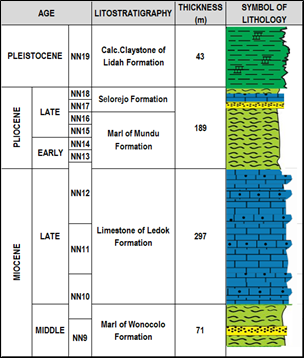Trace Fossils Of The Selorejo Formation, Rembang Zone, North East Java Basin, Indonesia
DOI:
https://doi.org/10.25299/jgeet.2023.8.3.10454Keywords:
Trace fossils, Ichnofacies, Rembang zone, North East Java basinAbstract
The Rembang Zone of the North East Java Basin is a zone that develops as a petroleum system and is one of the areas with Indonesia’s largest oil reserves. One of the lithologies in the Rembang Zone is a sedimentary rock carbonated as a marker of marine sediments. The outcrop is continuous and rich in trace fossils, especially in the Ledok and Selorejo Formations. The existence of trace fossil outcrops is crucial for the learning process of earth science, biology, and other sciences, but recently these outcrops have been closed and have become damaged. Their numbers are decreasing due to community mining activities, so unique research on trace fossils in the Rembang Zone must be done immediately. This research aims to discover the variation of trace fossils found in the Selorejo Formation. The methods used are field mapping, measured stratigraphic measurements, rock sampling, and laboratory analysis (sedimentology, petrography, and paleontology). The research shows trace fossils in Planolites, Helminthopsis, Thalassinoides, Conichnus, Chondrites, Macaronichnus, Bergauria, Ophiomorpha, Skolithos, Terebellina, Palaeophycus, and Asterosoma.
Downloads
References
Baucon, A., Bednarz, M., Dufour, S., Felletti, F., Malgesini, G., Neto de Carvalho, C., Niklas, K. J., Wehrmann, A., Batstone, R., Bernardini, F., Briguglio, A., Cabella, R., Cavalazzi, B., Ferretti, A., Zanzerl, H., & McIlroy, D. (2020). Ethology of the trace fossil Chondrites: Form, function and environment. Earth-Science Reviews, 202(October 2019), 102989.
Choiriah, S. U., Prasetyadi, C., Kapid, R., & Yudiantoro, D. F. (2020). Nannofossil distribution and age of Kendeng zone in Kalibeng river section of Kedungringin, Plandaan Area, Jombang, East Java. Indonesian Journal on Geoscience, 7(1), 15–24.
Choiriah, S. U., Prasetyadi, C., Yudiantoro, D. F., Kapid, R., & Nurwantari, N. A. (2020a). Miocene to pleistocene biostratigraphy of Rembang Zone based on nannofossil, Nglebur River section, Blora, Central Java. AIP Conference Proceedings, 2245, 1–11.
Choiriah, S. U., Prasetyadi, C., Yudiantoro, D. F., Kapid, R., & Nurwantari, N. A. (2020b). Pliocene-Pleistocene Calcareous Nannoplankton Biostratigraphy, Section Banyuurip, Rembang Zone, East Java Basin, Indonesia. International Journal of Geology and Earth Sciences, 6(4), 44–49.
Choiriah, S. U., Subandrio, A., Intan, P. H., Rizkianto, Y., Nurwantari, N. A., Darmawan, M. A., & Wirandoko, H. (2022). Mengenal Fosil Jejak Dalam Tiga Dimensi. LPPM, UPN Veteran Yogyakarta.
Desai, B. G., & Saklani, R. D. (2015). Palaeocommunity Dynamics and Behavioral Analysis of Conichnus : Bhuj Formation (Lower Cretaceous),Kachchh-India. Ichnos, 22(1), 43–55.
Díez-Canseco, D., Buatois, L. A., Mángano, M. G., Rodriguez, W., & Solorzano, E. (2015). The ichnology of the fluvial-tidal transition: Interplay of ecologic and evolutionary controls. In Developments in Sedimentology (Vol. 68).
Dorador, J., Rodríguez-Tovar, F. J., & Miguez-Salas, O. (2021). The complex case of Macaronichnus trace fossil affecting rock porosity. Scientific Reports, 11(1), 1–7.
Gilbert, M. M., Buatois, L. A., & Renaut, R. W. (2019). Ichnology and depositional environments of the Upper Cretaceous Dinosaur Park – Bearpaw formation transition in the Cypress Hills region of Southwestern Saskatchewan, Canada. Cretaceous Research, 98, 189–210.
Husein, S. (2016). Fieldtrip Geologi Cekungan Jawa Timur Utara. 2(December 2016), 1–31.
Knaust, D. (2017). Atlas of Trace Fossils in Well Core. In Atlas of Trace Fossils in Well Core (1st ed., Issue March). Springer International Publishing.
Knaust, D. (2021). Ichnofabric. Encyclopedia of Geology, 520–531. https://doi.org/10.1016/b978-0-12-409548-9.12051-2
Metz, R. (2022). Cruziana and Helminthopsis in fluvial deposits of the uppermost Stockton Formation (Late Triassic), west-central New Jersey. Ichnos, 29(2), 76–83.
Nagy, J., Tovar, F. J. R., & Reolid, M. (2016). Environmental significance of Ophiomorpha in a transgressive–regressive sequence of the Spitsbergen Paleocene. Polar Research, 35(1), 24192.
Pirrone, C. A., Buatois, L. A., & Bromley, R. G. (2014). Ichnotaxobases for bioerosion trace fossils in bones. Journal of Paleontology, 88(1), 195–203.
Pramunita,Siska W., Pandita, Hita., Rizqi, A. H. F. (2020). Analisis Kepadatan Fosil Jejak Sebagai Parameter Tingkat Kandungan Oksigen Dan Perubahan Lingkungan. GEODA, 01(02), 1–18.
Santoso, W. D., Insani, H., & ., Kapid, R. (2014). Paleosalinity Conditions on Late Miocene – Pleistocene in the North East Java Basin, Indonesia Based On Nannoplankton Population Changes. Riset Geologi Dan Pertambangan, 24(1), 1–11.
Van Bemmelen, R. W. (1949). The Geology of Indonesia. General Geology of Indonesia and Adjacent Archipelagoes. In Government Printing Office, The Hague (pp. 1–766).
Widiatama, A. J., & Santy, L. dwita. (2022). Ichnofossils characteristics in the pelagic and siliciclastic carbonate turbidites of Weda Formation, Halmahera Island. July, 59–70.
Wroblewski, A. F.-J., & Gulas-Wroblewski, B. E. (2021). Earliest evidence of marine habitat use by mammals. Scientific Reports, 11(1), 8846.
Zhou, X., Jiang, Z., Quaye, J. A., Duan, Y., Hu, C., Liu, C., & Han, C. (2019). Ichnology and sedimentology of the trace fossil-bearing fluvial red beds from the lowermost member of the Paleocene Funing Formation in the Jinhu Depression, Subei Basin, East China. Marine and Petroleum Geology, 99, 393–415.

Downloads
Published
Issue
Section
License
Copyright @2019. This is an open-access article distributed under the terms of the Creative Commons Attribution-ShareAlike 4.0 International License which permits unrestricted use, distribution, and reproduction in any medium. Copyrights of all materials published in JGEET are freely available without charge to users or / institution. Users are allowed to read, download, copy, distribute, search, or link to full-text articles in this journal without asking by giving appropriate credit, provide a link to the license, and indicate if changes were made. All of the remix, transform, or build upon the material must distribute the contributions under the same license as the original.










